Melbourne Tram Museum
- Follow Melbourne Tram Museum on Twitter
- Follow Melbourne Tram Museum on Facebook
- Follow Melbourne Tram Museum on Instagram
- Follow Melbourne Tram Museum on Pinterest
- Follow Melbourne Tram Museum on Tumblr
- Subscribe to Melbourne Tram Museum's RSS feed
- Email Melbourne Tram Museum
Never a paying passenger: the Fitzroy, Northcote & Preston Tramways Trust
The Northcote City Council became a reluctant tramway owner in 1901, purchasing the defunct Clifton Hill to Preston cable tramway and tendering out operations to a lessee. Over the next ten years, councillors observed the profitable operation of the cable tramway and the beneficial effect it had on stimulating commercial and residential development in the areas it served along High Street, substantially improving the council’s income obtained through property rates.
However, the development of the suburbs on the western side of the parallel railway line had not kept pace with that of the areas served by the cable tram line. There was a cable tramway operated by the Melbourne Tramway & Omnibus Company (MTOC) that terminated in North Fitzroy, at the intersection of St George’s Road and Barkly Street. Unfortunately for the council, MTOC was not interested in incurring massive capital costs by extending its cable tramway into an undeveloped area, viewing it as a speculative endeavour with minimal prospects for generating profits.
The lower construction costs of an electric tramway in comparison to a cable tramway as exemplified on the other side of the Yarra River by the Prahran & Malvern Tramways Trust from 1910 was viewed by municipalities in the northern suburbs of Melbourne with keen interest.
As a result, the Fitzroy, Northcote and Preston municipalities formulated a proposal to construct and operate an electric tramway as a municipal tramways trust, with routes commencing at the North Fitzroy cable tramway terminus and continuing northwards along St George’s Road to Miller Street, Preston. There the tramway would split into two branch lines, one heading westwards along Miller Street and then turning north along Gilbert Road to terminate at Regent Street, West Preston.
The second branch line would turn eastwards along Miller Street, crossing the railway line and then turning north along Plenty Road to terminate at Tyler Street, East Preston. This would allow cable tram passengers to transfer from the northern terminus of the Northcote cable tram on to the electric tram.
The proposal found support in State Parliament, and the Fitzroy, Northcote and Preston Tramways Trust (FNPTT) was constituted and incorporated under the provisions of the Fitzroy, Northcote and Preston Tramways Act 1915 (No.2592) which came into operation on 3 August 1915.
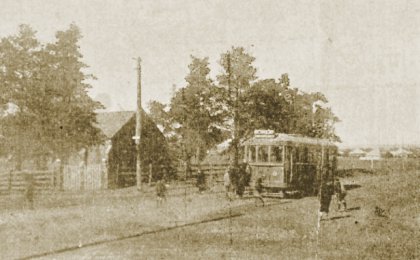 FNPTT
No 8 at Tyler Street, East Preston, terminus, 1920.
FNPTT
No 8 at Tyler Street, East Preston, terminus, 1920.- Photograph courtesy City of Darebin.
Constitution of the Trust
The Trust consisted of ten members, three being elected by each of the constituted councils (Fitzroy, Northcote and Preston) for a period of two years, the tenth member being the Chairman. The Chairman was elected by a conference of the municipal councils for a period of four years. In the event of a vacancy, the Minister of Public Works could appoint a replacement. Alderman C. Ottery of Fitzroy was appointed Chairman of the Trust on 2 October 1915 and retained this position for its entire existence.
For the purposes of the Act, the Trust was to exercise the rights, powers and privileges of a municipal Council, which were conferred on the Councils under the provisions of the Tramways Acts, 1890 and 1915, and were as follows:
- The Trust had the objective of constructing, managing and operating the defined electric tramways in the municipalities of Fitzroy, Northcote and Preston.
- The Trust could purchase, produce, supply and use electric energy for the purpose of any tramway undertaking, and was required to maintain the roadway in repair where its tramways were constructed, to the extent of eighteen inches to the outside of the outermost running rails.
- The Trust could enter into contract with any person or any corporation, invest money in government or municipal debentures, and establish funds to provide for any of its employees in the event of sickness or an accident and to pay gratuities or retiring allowances to any of its employees.
- The Trust also had the power to lease tramways with the consent of the local Council and the approval of the Governor-in-Council. The rent received was to be distributed between the municipalities, after payment of interest and repayment of any money borrowed by the Trust and payment of the other expenses of the Trust.
- The Trust was empowered to borrow money on overdraft from the bank up to ten thousand pounds. It could also borrow on debentures secured upon the security of the undertaking and the credit of the municipalities concerned. The Trust was to submit an annual balance sheet, showing its assets and liabilities and its revenue and expenditure to the local councils. The balance was to be divided between the municipalities. Any operating loss incurred by the Trust was to be made good by the municipalities.
In the event of dissolution of the Trust the surplus assets were to be divided among the municipal councils in proportion to their respective capital interests in the undertaking of the Trust, unless the Trust was being absorbed by a general tramway authority.
The municipalities were required to indemnify the Trust against capital loss in the undertaking.
In the event of any dispute between the municipalities and the Trust, the matter was to be settled by the Minister of Public Works.
The tramline was to be divided into five fare sections, each section requiring an adult penny fare. A through adult ticket from North Fitzroy to either terminus was to cost threepence. The corresponding fare for children under twelve or schoolchildren under eighteen was twopence, with each section requiring a halfpenny fare.
Wartime conditions made sourcing funds difficult. The first borrowings were obtained from the Gillott Estate on 23 February 1916, being a total of £35,000 at 5½% for a five year period. Subsequently, debentures were placed, but the total amount required for construction could not be obtained immediately. It was not until 22 June 1917 that the final £50,000 required was obtained from the State Savings Bank at 5¾% for a five year term.
The FNPTT seriously considered an overture from the Melbourne, Brunswick & Coburg Tramways Trust for amalgamation of the two municipal tramways trusts, but had dismissed the concept by February 1916.
Construction
The construction of the FNPTT tramway offered three significant engineering challenges. The first challenge required the replacement of the Merri Creek Bridge , which carried St Geroge’s Road across the watercourse. Originally constructed in 1888, the bridge was not rated to carry heavy electric tramcars. Therefore, the first major work undertaken by the FNPTT was construction of a replacement bridge. The tender for the new bridge was let to a Mr W.T. Grant at a total cost of £8,359, and the consulting engineers were Messrs. McCarty and Underwood, who were also consulting engineers for the entire tramway as well as to the Hawthorn Tramways Trust. The foundation stone was laid on Saturday 18 August 1917 by Mr J.G. Membrey MLA, the member for Jika Jika. The Merri Creek Bridge is still carrying trams and road traffic to this day.
The contract for the permanent way was let to Edward Carroll of Malvern on 27 Aug 1918 at a cost of £26,460. After construction of the Merri Creek Bridge was completed, work commenced on the permanent way south of the bridge in Fitzroy on 10 September 1918. The line from the southern terminus to Miller Street was double track, with both branches to East and West Preston being single track.
The second engineering challenge was the presence of the main water supply pipeline from Yan Yean Reservoir in the St George’s Road reservation. The cast iron pipes that had been laid underground could not take the weight of an electric tramway being laid on top of them. The result of this limitation was that the double track tramway was constructed on the western carriageway of St George’s Road, which led to the inward bound trams running directly into oncoming traffic for the next seven decades, until the reconstruction of the tramway and crossing of the water pipelines with ground level bridges.
The final engineering challenge was the construction of a single track trams-only overbridge [1] of the Whittlesea railway in Miller Street. This bridge was required due to the opposition of Victorian Railways to tramway level crossings with their railway lines.
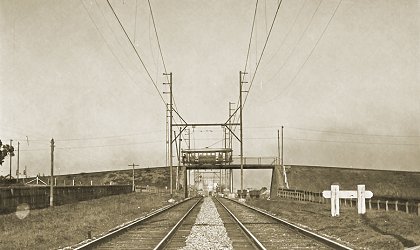 R
class tramcar crossing newly electrified section of the Whittlesea
railway, Miller Street Thornbury, circa 1921.
R
class tramcar crossing newly electrified section of the Whittlesea
railway, Miller Street Thornbury, circa 1921. - Photograph courtesy City of Darebin.
Tenders were let for the construction of the overhead & track lighting on 30 August 1919. Construction of the tramway was far enough advanced to allow a trial run of FNPTT car number 1 on Tuesday 27 January 1920 over the entire line, the only time the FNPTT operated a tramcar. Among the passengers on the trial run were local members of parliament the Hon W.J. Beckett MLC, Mr J. Cain MLA and Mr Martin Hannah MLA, as well as representatives of the councils and the Trust.
Tramcars
Eight tram car bodies were ordered from James Moore and Sons and assembled in the Prahran and Malvern Tramways Trust (PMTT) workshops in Coldblo Road, Malvern. The design of the tramcar bodies was based on PMTT tramcars numbers 92-100, being a straight-sill California combination design. The car bodies were mounted on Brill 21E trucks, but they used different electrical equipment from the PMTT cars. Also unlike PMTT cars, they were built with airbrakes as the service braking system. All cars were delivered in 1920.
The eight tramcars were later classified by the M&MTB as R class cars, and numbered 151-153 and 172-176. In 1936 the M&MTB disposed of three cars: 173 was scrapped following accident damage, while 152 and 153 were sold to the State Electricity Commission of Victoria, serving as Ballarat 29 and Bendigo 22 until 1950 and 1956 respectively. Cars 151 and 174-176 were modified for use as all-night cars in 1937, while all remaining R class cars were disposed of between 1955 and 1957.
| FNPTT No | 1-8 |
|---|---|
| Type | Single truck straight sill closed combination car |
| Car body builder | James Moore & Sons, South Melbourne |
| Entered service | 1920 |
| M&MTB Class | R |
| M&MTB No | 151-153, 172-176 |
| Truck type | Brill 21E |
| Motors | 2 x 50 hp (GE 203) |
| Controllers | GE K36JR |
| Service brake | Compressed air |
| Weight | 11.7 tons |
| Length | 33 feet 0 inches |
| Wheelbase | 7 feet 6 inches |
| Seated passengers | 36 |
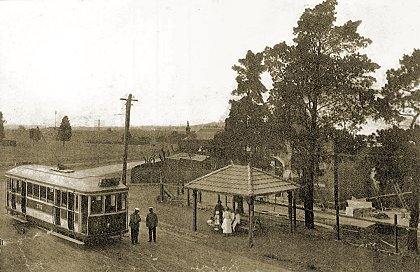 R
class tramcar 176 at Tyler Street, East Preston, terminus, circa 1920.
R
class tramcar 176 at Tyler Street, East Preston, terminus, circa 1920.
- Photograph courtesy City of Darebin.
The body of R class car 153 – the only surviving FNPTT tramcar – survives in the care of the Bendigo Tramways in the Gas Works Depot, after it was recovered in 1995 from its use as a wood shed at a Bendigo residence.
Depot
The four road depot building was constructed at the junction of the two branch lines to East and West Preston, on the north-western corner of the intersection between St George’s Road and Miller Street, Preston. A somewhat uninspiring building of brick construction, it was considerably larger than was required to house the original order of eight tramcars. Clearly, the management of the FNPTT had learnt from the lessons of the Hawthorn Tramways Trust, which had not built sufficient depot storage space to cater for traffic growth.
The depot was later enlarged by the M&MTB with another tram barn of five roads on the eastern side of the original depot building.
After the opening of the new Preston Depot on Plenty Road in 1955, the old Preston Depot closed for operations, being used for storage of surplus tramcars and as an overflow area for Preston Tramway Workshops, which was constructed on the other side of St George’s Road, and opened in 1926. In this form, the depot became known colloquially as Thornbury Depot, to differentiate it from the new Preston Depot. One of the interesting aspects regarding the construction of the depot was that the two weatherboard cottages occupying the site prior to construction were sold for removal on behalf of the Trust by Membrey and Deane auctioneers of 17 Queen Street Melbourne on 31 July 1918. The auctioneer was J.G. Membrey, former MLA for Jika Jika, who was later a member of the Melbourne & Metropolitan Tramways Board from 1919. Membrey and Deane was to maintain a connection with Melbourne tramways, auctioning the North Fitzroy cable tram depot on behalf of the M&MTB in 1937.
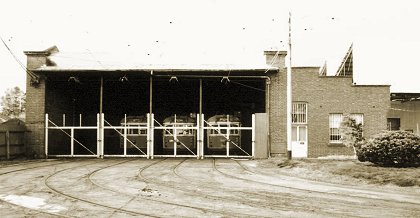 Old
Preston depot, 9 September 2002. W class sliding door cars in store.
Old
Preston depot, 9 September 2002. W class sliding door cars in store.- Photograph courtesy David Langley.
In December 2006 Thornbury Depot was demolished and the land sold for redevelopment. The depot foundation stone is now in the collection of the Melbourne Tram Museum.
Opening
The assets of the FNPTT were acquired by the Melbourne & Metropolitan Tramways Board on 2 February 1920, being valued at £129,809, the Trust having never carried a paying passenger. A few weeks later tramway construction was completed, drivers and conductors were trained and the tramway was ready for opening.
The service was inaugrated on Thursday 1 April 1920. There were three ribbon cutting ceremonies conducted in front of the official first car. The first ribbon at North Fitzroy was were cut by Mrs Ottery, the wife of the former Chairman of the Trust, the second ribbon being cut at Miller Street by the daughter of Mr J G Membrey of the Tramway Board, while the final ribbon was cut at Preston by Mrs Llewellyn Jones, wife of the Preston Shire president. After the first trip, the official car returned to the new tram depot, where a banquet with the usual speeches and loyal toasts was held. One of the speakers at the ceremony was Alex Cameron, the newly appointed Chairman of the M&MTB.
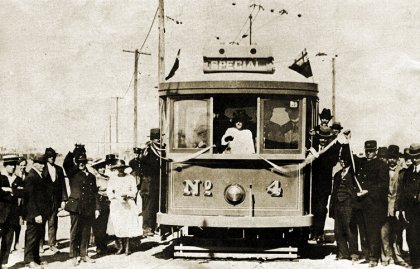 Miss
Membrey cuts the ribbon from the driver’s cab of FNPTT No 4 –
opening day at Miller Street, 1 April 1920.
Miss
Membrey cuts the ribbon from the driver’s cab of FNPTT No 4 –
opening day at Miller Street, 1 April 1920. - Photograph courtesy City of Darebin.
The FNPTT lines today
All of the former FNPTT tram routes still exist today, although there are no passenger services along Miller Street between St George’s Road and High Street, this line section being used to allow West Preston trams to run in and out of the new Preston Depot on Plenty Road. The rest of the FNPTT East Preston line now forms part of route 86 to Mill Park, which runs to the city along High Street, the route of the old Northcote cable tramway.
The St George’s Road main line and West Preston branch now form
part of route 112, the South Melbourne beach to West Preston route.
The suburbs served by the FNPTT lines developed primarily into residential
or light industrial zones – the role of a substantial retail shopping
strip had already been filled by High Street Northcote to the east of
St George’s Road and the Whittlesea railway, or Brunswick Street
Fitzroy to the south – both zones created by the original cable
tram routes.
Bibliography
The Argus newspaper (1915-20)
Cross, N., Budd, D., and Wilson, R. (1993) Destination City (Fifth
Edition), Transit Australia Publishing
Jones, R. (2004), Northcote: the on again,
off again cable tramway, Melbourne Tram Museum
Jones, R. (2005), Fares Please: An
economic history of the M&MTB, Melbourne Tram Museum
Keating, J. D. (1970) Mind the Curve!, Melbourne University Press
Kings, K.S. and Richardson, J. (1965), Destination Eaglehawk,
Traction Publications
M&MTB (1930) Melbourne & Metropolitan Tramways Board – Its Progress
and Development 1919-1929
PMTT (1919) Annual Report
Other sources
Public Records Office Victoria Fitzroy, Northcote & Preston Tramways Trust: Agency VA 2972
Footnotes
[1] The Miller Street tram overbridge would later become colloquially known by tramway staff as ‘Mount Buggery’, partly due to the steep gradients required to clear the railway line.